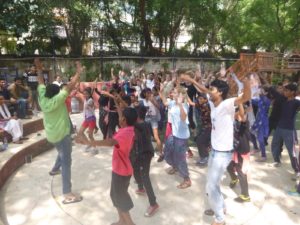A firsthand look at strategy and sustainability in India
Over the course of three weeks, I traveled from Chennai to Bangalore to Mumbai to Delhi with a group of U-M undergraduate business students learning about business strategy and sustainability in India. They were tasked with developing a unique, innovative, scalable, for-profit business that addressed at least one of the UN’s 17 sustainable development goals. Students visited governmental organizations, Indian companies from various economic sectors, multinational companies, entrepreneurial ventures and NGOs to learn firsthand about the standard practices of business in India. Students were able to speak directly with business leaders and learn about cutting-edge entrepreneurial strategies that are essential to expand and succeed in a developing country.
Companies
The entrepreneurial spirit is strong in India. We learned about the incredible base of the pyramid market, got to meet with the CEOs of several start-ups and learned about challenges and opportunities these organizations face. We visited a Freshdesk, an edgy start-up with a sweet office space (someone please tell me why we haven’t invested in nap rooms at Erb!), and spent a day meeting with executives and touring the factories at CarratLane, India’s largest e-commerce jewelry retailer. In Mumbai, we raced alongside the Dabbawalas as they completed their mission of delivering about 200,000 meals a day. The Dabbawala are semi-literate people from rural Maharashtra who have created an empire for delivering freshly made foods from the homes of Indian employees to their workplaces. They are recognized for delivering a Six Sigma level of accuracy in their service (a 1 in 6 million chance of error!). We visited Yum Brands’ Indian headquarters and toured one of their franchises that hires 50 percent deaf employees. In a country with few resources for citizens with disabilities, Yum Brands gives this population access to fair-paying jobs and opportunities for a management growth path. Our visit to Bangalore wouldn’t have been complete without a taste test at Arbor Brewing (yes, the same one that’s in Ann Arbor!) and learning about the CEO’s plans for creating a more environmentally sustainable brewpub.
opportunities these organizations face. We visited a Freshdesk, an edgy start-up with a sweet office space (someone please tell me why we haven’t invested in nap rooms at Erb!), and spent a day meeting with executives and touring the factories at CarratLane, India’s largest e-commerce jewelry retailer. In Mumbai, we raced alongside the Dabbawalas as they completed their mission of delivering about 200,000 meals a day. The Dabbawala are semi-literate people from rural Maharashtra who have created an empire for delivering freshly made foods from the homes of Indian employees to their workplaces. They are recognized for delivering a Six Sigma level of accuracy in their service (a 1 in 6 million chance of error!). We visited Yum Brands’ Indian headquarters and toured one of their franchises that hires 50 percent deaf employees. In a country with few resources for citizens with disabilities, Yum Brands gives this population access to fair-paying jobs and opportunities for a management growth path. Our visit to Bangalore wouldn’t have been complete without a taste test at Arbor Brewing (yes, the same one that’s in Ann Arbor!) and learning about the CEO’s plans for creating a more environmentally sustainable brewpub.
Alumni
In each city, students vetted a phase of their project with Ross alumni. The alumni not only had incredible work experiences but also were able to suss out gaps in the students’ projects very quickly. During our first alumni dinner in Chennai, it became apparent that ideas that could have succeeded in the U.S. weren’t constructed with an eye to the Indian markets’ unique risks, challenges and opportunities. After each check-in with alumni, students had to go back to the drawing board to improve their ventures.
NGOs
We visited a handful of NGOs to understand how they were maintaining cultural relics, advocating for public health and sustainability and fostering inclusive learning environments to fill educational gaps. In Chennai, we learned about the dedication required to maintain India’s rich history of music, theater and dance. Students dedicate six long years to be trained in the professional arts. In India, the life of a performer is rarely advantageous and often short-lived. And yet, thanks to incredible talent and drive, many of India’s arts will remain flourishing in a society that is transforming at a breakneck pace. In Mumbai, we visited the home of Sundara, a nonprofit started by a UM alum. Sundara’s mission is simple: Give children in slums access to soap and teach basic hygiene to eradicate diseases that are prevalent there. Sundara collects gently used soaps from hotels and repurposes them into a new product for free distribution in the slums. In Delhi, we visited Manzil, a school that offers children in low-resourced schools a chance at building skills, fostering talents and growing a community of support. Students get to share their knowledge with peers and build skills that range from computer coding to dance.
Cultural attractions
In each city, we visited cultural heritage sites, including the Taj Mahal. However, it was the winding, congested, chaotic streets of  Mahabalipuram in Chennai that will be forever imprinted in my mind. The colors, the chaos, the distinct smells and dizzying congestion gave me a glimpse of the road less traveled by tourists.
Mahabalipuram in Chennai that will be forever imprinted in my mind. The colors, the chaos, the distinct smells and dizzying congestion gave me a glimpse of the road less traveled by tourists.
Takeaways
Opportunities for business are ripe in India’s fast-growing market, especially among the tech sector. There is a burgeoning population of youth and a market that relies heavily on technology. At the same time, there is a pressing need for businesses to combat some of the country’s greatest sustainability challenges. Pollution and lack of access to clean water, health care and education pose major risks. Learning alongside the students and speaking with locals, business leaders, volunteers and members of the government left me optimistic that businesses have the potential to take on these challenges in new and creative ways.
